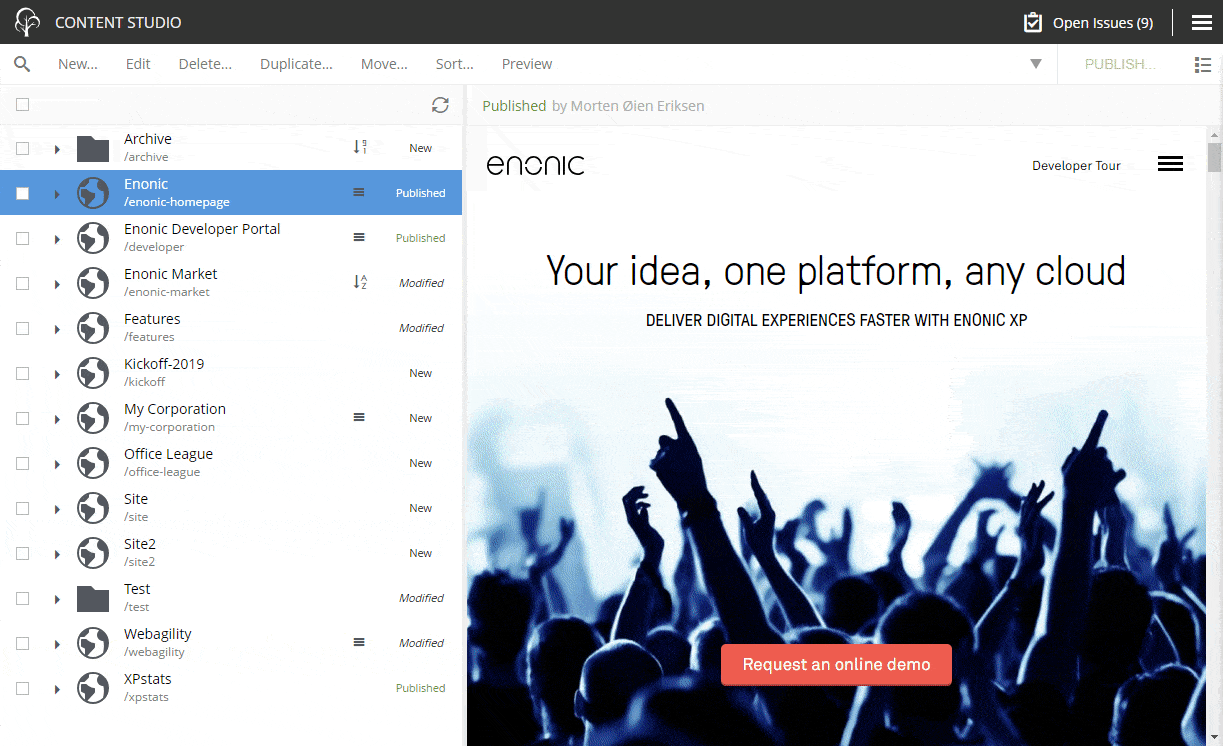Contentful vs. Enonic
See a comparison between Contentful and Enonic, with an essential overview of similarities and differences.
Written by Morten Eriksen on

See a comparison between Contentful and Enonic, with an essential overview of similarities and differences.
Written by Morten Eriksen on
Finding a tidy, but still technical overview of content management systems and digital experience platforms may be difficult. Our series of CMS comparisons aims to clarify the similarities and differences, strengths and weaknesses, use cases and real-life usage examples between Enonic and another vendor. Now the turn has come to Contentful.
Contentful was founded in Germany in 2012. The company styles itself as a content platform, even going as far as not to be identified as a CMS.
No matter what we call it, Contentful allows content to be delivered in a “presentation-independent format,” fitting for any channel through GraphQL and REST APIs. Developers can build clients in the most common programming languages through SDKs.
While the developers get their fill with the pure headless approach and so-called language and framework agnosticism, editors can make use of the Contentful Web App for content editing, versioning, and image handling. To see how content will be presented, editors can use a preview API, which must first be set up by developers.
Lately they have launched functionality for building and deploying web pages, through Compose + Launch. This offers more features for managing websites and landing pages.
Based on the first page of their website, the use cases they focus on are Global Marketing and Localization, Agile Commerce and Centralized knowledge bases.
See also: Enonic: Platform for the Future »
Enonic was founded in Norway in 2000. The company’s content platform is delivered as a ready to use cloud service or software to host in your own cloud. With Enonic you can easily configure content models, access content using the GraphQL API, manage landing pages, and integrate contextual preview. This enables you to build modern websites and content experiences to support multiple touchpoints in the digital customer journey.
The platform features an integrated storage and search engine enabling storing of any data, including user generated content. The CMS interface “Content Studio” features a WYSIWYG interface, permissions and roles management, version control, multi-site management, localization and advanced image editing.
Enonic is open-source, meaning you can try it extensively before subscribing to the cloud service or software support. It is also a hybrid CMS, which means that developers can use the headless API to distribute editorial content to any device or client, but you can also build custom APIs, extend the user interface, and deploy integrations.
The use cases Enonic focus on are modern stack websites, global marketing sites and customer portals.
Users on the review platform G2 have the following to say about Contentful:
“What I like best is managing content and customizing it. Also, how the teams can collaborate on a particular project is a plus. The platform gives a very user-friendly approach to beginners. I was able to familiarize the Contentful with minimal supervision,” says Christine.
“Best cloud-based content management system. Easier maintenance of contents with kind of deployment slots environments. Compose makes our life easier by displaying all the pages in a single table view,” says a user in Financial Services.
“It has different environment support to use for QA, DEV, MASTER. The platform lets you make, manage, and distribute content to any platform,” says Vasanthi.
“Migrating the environments is the toughest job here. It's hard to integrate Apps with the app framework. You need to maintain the server of the app you create,” also says Vashathi.
“The content authoring UX can be painful for non-technical users. The CMS does not seem suited to handle general purpose marketing websites. Exceeding plan limits can be very expensive. No public roadmap for upcoming features,” says an administrator in Health, Wellness and Fitness.
“What I dislike about Contentful is that due to the high volume of users, it can be slower at times, and it can also be challenging to customize certain things,” says a user in Hospital & Health Care.
Learn more: Why go headless with a hybrid CMS?
G2 users say the following about Enonic:
“I like the flexibility of the Enonic. You can choose from several approaches on how to use the system. We, for example, take advantage of the Headless CMS, where our client part is created in Angular. The definitions of the content structures are entirely in our hands and can describe both simple and very complex data.” says Pavel.
“I like the UX which anyone with a tad of prior experience from blog systems and WordPress-like systems will recognize,” says Håvard.
“Enonic is versatile, robust and user-friendly. I love the hybrid approach, combining both headless and traditional editorial functionality. We use it for multiple sites at Gjensidige, and have successfully integrated it with our design system,” says Torstein.
“I would love to see an improvement in tutorials and code examples that could inspire us to take more advantage of the platform,” says an administrator in Financial Services.
“I would have liked an even bigger community, so please consider trying it out,” says Torstein.
“The documentation could be better and include more complex examples. It would also be nice if there were more apps on market.enonic.com,” says an agency in Information Technology and Services.
Learn more: This is what customers say about Enonic »
See also the G2 Compare report between Contentful and Enonic.
| Contentful | Enonic |
Coding language | Any client language | Any client language and JavaScript for server side customizations to build integrations, scheduled tasks, APIs etc. |
Database requirements | N/A, only SaaS | None, embedded NoSQL when running in your cloud. |
License | MIT License for SDK | The platform is licensed as GPLv3 with linking exceptions and a commercial license for paying customers. Apache 2.0 for libraries and most extensions. |
Source code | Open source SDK (GitHub) | Fully open source on GitHub |
Integrated search | Yes, can also be expanded with e.g. Algolia | Yes. Also delivers a Search Engine called Explorer to index external sources and administrate the search options. |
Headless API | Yes, based on REST and GraphQL | Yes, based on GraphQL. Can be customized to your needs using server side JavaScript. |
Flexible content types | Yes | Yes |
WYSIWYG page editor | No | Yes |
Responsive UI | Customization | Yes |
Hierarchical content structure (tree structure) | No | Yes, with access rights on different levels. |
Image service | Yes, separate app for focal point | Yes, including focal point |
SEO management | Yes, through content modeling. | Yes, an app from Enonic Market or content modeling. |
Version control | Yes | Yes |
Localization | Yes, single content linking to translations. | Yes, using layers with full flexibility on user access and translation. |
Video content | Yes, as assets | Yes, as assets |
Hosting | Contentful is hosted on Amazon’s AWS on the US East Coast | Runs anywhere:
|
CDN | Yes | Yes, with multiple options powered by Cloudflare |
Support plans | Yes, by vendor | Yes, by vendor |
Free support | Community, Slack, chat | Forum, Slack, chat |
Community | Yes | Yes |
Training | Yes, by vendor | Yes, by vendor |
Plugins | Yes, apps from Marketplace | Yes, apps from Enonic Market |
After having created a custom content type—like an article—you fill in the included fields systematically. You can also add custom fields during the publishing process or later. Then finally you decide which Content Delivery API Key to use in order to deliver the content to a given channel.
You determine the location of a content item in Content Studio through a logical tree structure. Once the blog post draft is created, you can navigate through fields systematically, before saving, previewing, and finally publishing. The content is available using the GraphQL API in draft and master branches during the authoring process.

Contentful is a good match if your developers are looking to build web apps and native apps quickly and seamlessly. If you want to distribute content somewhere fast, and are happy with the existing APIs, cloud service, and functionality in the headless CMS, Contentful is a reasonable choice.
Enonic provides freedom on all levels, including hosting, customization, visual page editing and content models. Enonic also enables you to store content hierarchically to reflect your site structure or for maintenance purposes. The Enonic platform can work as a pure headless CMS, but allows for back-end customization, satisfying both developers and editors alike.
First published 9 December 2020, updated 20 April 2022.
Get some more insights: